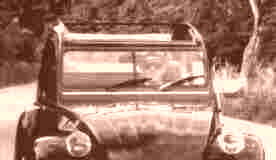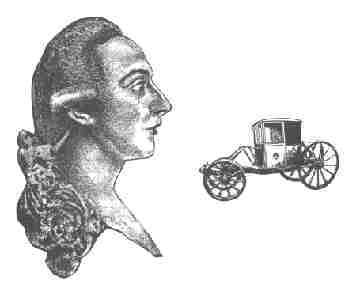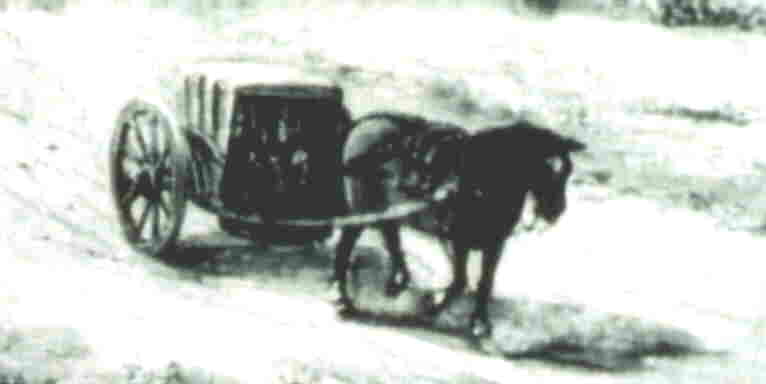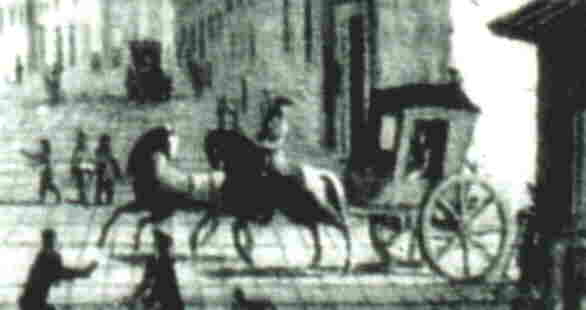

THE CASANOVA TOUR
by Pablo Günther
TRAVELLING CARRIAGES (parts III - VIII) - Carriages mentioned by Casanova - Carriages in Virginia and England - Notes on the Goodwin Report - Two-Wheeled Carriages - (part IV)
"You mean," Marcolina asked me,
"to give me your carriage too?"
I could not answer.
I pretended to blow my nose,
and I went to the window to dry my tears.
Giacomo Casanova, History of My Life.

These pictures reminds one of the horses used for travelling - the post horses. Before the age of railways and motorcars, fast travelling without horses was impossible. The system of changing horses at every stage meant that Casanova probably paid for and used over 6000 individual horses when he travelled in his own carriage.
Top: Stage-coach, Southern Germany, about 1780. Painting by Christian G Schütz. - Bottom: Napoleon I and his English Post Chariot in 1813/14. - Photos: PG.
In Casanova's History of my Life - written in the French language - he makes reference to almost all types of carriages of his time.Carriages mentioned by Casanova.
No. Year* Type of carriage ................. Wheels/Seats ...... Location----------------------------------------------------------- o--O -------------------------------------------------------
Commentary
[* The year in which the type is mentioned for the first time.]
[Capital letters: own carriages.]
-------------------------------------------------------------------------------------
1. 1742 Calèche à 2 roues ....................... 2/2 .............. Venice
folding top
2. 1744 Carosse Coupé ........................... 4/2 ............... Rome / Cologne 1760
closed; one perch (cf. 8. berlin)
3. 1744 Phaéton ..................................... 4/2-6 ............ Rome / Turin 1761
open, "calash without top"
4. 1744 ... Vis - à - vis ................................. 4/2 .............. Rome
closed or open; two seats face to face
5. 1749 ... VOITURE ANGLAISE ............... 4/2 ........... Bologna
English Post Chariot / Post Chaise; closed or convertible
6. 1749 ... Chariot de poste ......................... 4/x .......... Bologna;
--- 1764 ... Chariot de poste .............................4/x ........ Germany
stage wagon
7. 1750 ... Chaise;......................................... 2/2 .......... Ferrara;
--- 1750 ... barelle de poste / petit chariot...... 2/2 ............. Padua
Sedia; closed or half open
8. 1750 ... Berlin ........................................... 4/4 .......... Ferrara
closed; two perches (cf. 2. & 18. carosse)
9. 1750 ... Diligence ...................................... 4/8 ........... France
"Flying" stage coach
10. 1750 ... Diable ........................................ 4/2 .............. Paris
a sort of calash, without a coachman's seat
11. 1750 ... Cabriolet .................................... 2/2 ............. Paris
open or folding top
12. 1757 ... Pot de chambre ......................... 2/1-2 ........... Paris
hired carriage, Fiacre
13. 1758 ... CHAISE DE POSTE .................... 2/1 ......... France
closed; steel springs
14. 1758 ... Calèche à 4 roues ....................... 4/4 .... Amsterdam / Lyons 1763
folding top over the 2 rear seats
15. 1760 ... Chariot de poste ....................... 4/2 ? ....... Stuttgart
16. 1760 ... VOITURE OUVERTE ................. 4/4 ......... Zürich
open; four seats face to face
17. 1761 ... Mantice ....................................... 2/2 ........ Naples
Italian chaise; Cabriolet; folding top
18. 1761 ... Landau ........................................ 4/4 ......... Rome
convertible open / closed
19. 1763 ... Carosse ......................................... 4/4 ........ Milan
closed; one perch (cf. 8. berlin)
20. 1763 ... SOLITAIRE .................................. 2/1 ....... Lyons
Chaise de Poste
21. 1764 ... VOITURE A QUATRE ROUES ... 4/2 ........ Wesel
travelling coupé: presumably an English Post Chariot.
22. 1764 ... SCHLAFWAGEN ........................ 4/2 ........... Riga
Russian house-carriage
23. 1770 ... Carozzino ..................................... 4/4 ?........ Rome
24. 1771 ... COUPÉ ........................................ 4/2 ........ Naples
travelling carriage: presumably an English Post Chariot
It is interesting to compare the carriages mentioned by Casanova with those which can be documented in Virginia before 1800. Carriages were imported from London, but from about 1750 onwards, were also built in America. For Casanova research it is important that we know of many other examples and owners of Post Chariots and Post Chaises, a type called by Casanova "voiture anglaise". In a large measure we are indebted for this to an unique world wide inventory of carriages and carriage owners made by Mary R M Goodwin, "Wheeled Carriages in Eighteenth Century Virginia" (Colonial Williamsburg Research Report. Williamsburg 1959).Carriages in Virginia and England.
No. Year* Type of carriage** ................................ Wheels/Seats ... References----------------------------------------------------------- o--O -------------------------------------------------------
Commentary
(* The year in which the type is mentioned for the first time. - ** Capital letters: type also mentioned by Casanova, however sometimes in a [DIFFERENT TERM].)
------------------------------------------------------------------------------------------------------
1. 1677 ... Coach (old style) [CAROSSE] .............................. 4/4 ........ 40
closed; from 1724 onwards also the BERLIN which however
cannot be conclusively documented in Virginia (cf 6. Berlin-Coach)
2. 1688 ... CALASH ..............................................................4/2-4 ....... 2
top, open on the sides; later: folding top
3. 1690 ... Chaise ...................................................................4/2 ........ 34
open or folding top
4. 1710 ... Chariot (old style) [CAROSSE COUPÉ] ................ 4/2 ........ 30
closed "half coach"
5. 1720 ... Chair ......................................................................2/1-2 ... 100
open or folding top
(6. 1724 ... Berlin-Coach [BERLIN] ........................................ 4/4 ....... (1)
closed)
7. 1743 ... TRAVELLING CHAIR [CALÈCHE A 2 ROUES] ... 2/2 ........ 5
folding top
8. 1751 ... ITALIAN CHAIR / CHAISE [MANTICE] .............. 2/2 ....... 10
folding top; "Chaise à l'italienne"
9. 1754 ... (Town-) Chariot (new style) [COUPÉ] .................... 4/2 ........ 95
English Coupé; closed or convertible
10. 1757 ... POST CHARIOT [VOITURE ANGLAISE] ........... 4/2 ......... 39
English Coupé (with coachman's seat); closed or convertible
11. 1760 ... Curricle ................................................................ 2/2 .......... 4
12. 1760 ... Coach (new style) ................................................. 4/4 ......... 60
English Coach; closed
13. 1761 ... PHAETON ........................................................... 4/2-4 ...... 44
14. 1768 ... POST CHAISE [VOITURE ANGLAISE] ............... 4/2 ......... 22
English Coupé (without coachman's seat); closed or convertible
15. 1770 ... State Coach .......................................................... 4/4 ........... 1
of Governor Lord Botetourt; type uncertain
16. 1770 ... Post(ing) Coach .................................................... 4/4 ........... 3
closed; high-class travelling carriage
17. 1772 ... LANDAU ..............................................................4/4 .......... 10
convertible open / closed
18. 1772 ... Sulkey .................................................................. 2/2 ............ 2
open
19. 1772 ... Whiskey ............................................................... 2/2 ............ 1
open or folding top
20. 1776 ... Stage Wagon ....................................................... 4/6-8 .......... 9
public post carriage; closed
21. 1791 ... Coachee .............................................................. 4/6-8 .......... 2
private carriage for several persons; open on the sides
Property tax lists in Williamsburg from 1786 until 1799 serve as a more specific inventory of equipages (Goodwin, p.xxxi):Notes on the Goodwin Report.
Four-wheeled carriages: between 11 and 17 carriages; e.g. 1791: 11 Post chaises, 1 Chariot, 3 Phaetons, 1 Coach, 1 Coachee.Contrary to the Goodwin-Report, I have distinguished between "old" and "new" coaches and chariots, between the carosse-type and the new English type. Around 1750, a new age in carriage-building began with the invention of the Post Chariot, a type which I call "English Coupé".
Two-wheeled chairs: between 16 and 28 chairs; e.g. 1791: 26 Chairs.
Horses: between 123 and 194 horses; e.g. 1791: 178 horses.
Chairs and Chaises, Chariots (Carosse-Coupés) and Coaches (Carosses and Berlins).After 1760 we find:
(improved) Chairs and Chaises e.g. Italian Chaises, Phaetons, Coaches, Chariots, Post Chaises / Chariots and Landaus, all in the new English style and with the latest technical improvements.For the year 1724, the carriage situation in Virginia, as well as in England, is clearly outlined by the Reverend Hugh Jones of London (Goodwin, p.i):
(Those more or less built for travelling are underlined.)
"They [the "good families" in Williamsburg] live in the same neat manner, dress after the same modes, and behave themselves exactly as the gentry in London; most families of any note having a coach, chariot, berlin or chaise."The terms "carosse" and "berlin" did not appear in Virginia; they were all just referred to as "coaches". Both started as travelling and town carriages and graduated to coaches for high ceremonial use.
Further, the title page of Webley's famous work, which appeared in the year when Casanova lived in London (1763), might be of interest for the terminology of carriages (some of his designs are on show in this book):
T H E
NOBLEMAN and GENTLEMAN's
DIRECTOR and ASSISTANT,
I N T H E
True Choice of their WHEEL - CARRIAGES:
B E I N G
Entire new Designs for Travelling-Coaches, Post-Coaches, Landaus both open
and close, Chariots, Post-Chariots, Calashes, Post-Chaises, Phaetons, and other
Vehicles, &c. curiously hung on Steel Springs.
B E I N G
A Work of universal use, not only to Gentlemen, but Coach-makers and Spring-makers in general.
The Wheels and Axle-trees are made of a proper Height, so as to enable the horses to draw freely and with the greatest Ease; many a fine Horse having been totally spoiled by going up great Ascents, and all owing to fixing improperly the Wheels and Axis.
The Whole drawn from Original Designs, executed and correctly engraved on Thirty-six Copper Plates.
L O N D O N
Printed for A. W E B L E Y, in Holborn, near Chancery-Lane, 1763.
Chair, Chaise and Calash are often interchangeable terms. The bodies were of different shapes and had different equipment. The most important were:Two-Wheeled Carriages.
In Italy:In the 17th and 18th century, a typical Italian chair or chaise was the Sedia (French travellers, e.g. de Brosses in 1739, called it Chaise à l'Italienne). This was the universal carriage for private use, the rent-a-carriage of the post stations and other companies, and the standard carriage of the carriers (vetturini). For two persons, body open, enclosed or folding top, reminiscent of a bellows, which why Casanova once called this chaise "Mantice".
An open Sedia and one with a folding top, painted by Gaspar van Wittel in Rome about 1710. - Photos: PG.. .
The Sedia of Mr Gnecchi-Ruscone, Milano. Northern Italy, between 1730 and 1750, in excellent original condition:
The box can be taken off by 4 screws. The wheels are fastened only by a pin (cf. Transportation of Dismantled Travelling Carriages). - Photos and Copyright: Carlo Gnecchi-Ruscone, Inzago (MI).. . . . . . .
"The journey back from Rome can be done in two ways; either again with a Veturino, or by Post; and with the latter, either on horseback or in a Sedia. (...).
You can obtain Sedie everywhere in Rome at the harness-makers and at different prices. Usually a new one, which is not made extraordinairement luxurious, costs about thirty Scudi [1,800 Pence (d.)]. Sometimes you can get one at the harness-makers or buy one privatelywhich is already a little used; and these cost some Scudi less. However, one must observe the following when buying a Sedia:
1. To see that it is made of good wood, that the wheels are well ironed, and the brancard [perches, shaft] is strong.
2. That the body or seat is not hanging in braces, but directly placed on the brancard, because then you are less likely to overturn with it.
3. That the hood of the body is not made of leather but of oilcloth which is lighter, and will not become hard and stiff in the rain or sunshine like leather.
4. That you are not concerned with it being propre, but only commode.
5. That you prefer one which has wide rails rather than narrow, because later the fore-undercarriage can be mounted better. (...).
Will I, after doing the Tour through Italy, sell my Sedia again, so then I can be rid of it at Milan, Geneva, Padua, Augspurg or elsewhere. I am, however, of the opinion that it is better to have a fore-undercarriage put beneath it, perhaps at Trento, or at some other place where the German Posts begin, and roll on, rather than sell the sedia for bagatelle money."
(I shall discuss the fore-undercarriage in the section on the "Berlin".)
 . .
. . 
Two closed Sedie parked at the custom-station Pietra Mala, on the Raticosa-pass, between Florence and Bologna. - J. Smith, about 1780. From: Brilli, Il Viaggio in Italia. Photo (cutting): PG.
At Perugia in 1786, Johann Wolfgang von Goethe describes a vetturino's Sedia as follows (Italian Journey, p.120) :The later Italian Chaise, Calesso, Chaise à l'Italienne, had an improved folding top, similar to today. For private or public use, with some variations.
"With the Vetturini it is a disagreeable drive; the best thing is that you can follow them comfortably on foot. From Ferrara to here, I let myself be dragged on in this way. This Italy, highly favoured by nature in comparison with all countries, falls infinitely behind in all things mechanical and technical, which is the basis of a more comfortable and fresher way of life. The carriage of the Vetturini, which they still call a Sedia, is an arm-chair, originating from the old carried chairs in which women, elder and noble persons were conveyed by mules. Instead of the rear mule which they later harnessed alongside the shaft [in which the fore mule was], they put two wheels and no further improvement was thought necessary".
"Gentleman's Calesse". A modern closed body as a vetturino's Sedia. - Unknown artist, about 1810. Victoria and Albert Museum, London. Photo: PG. --- "Galessa di Resina vicino Napoli" (Resina and Portici formed one place). The number 24 identifies this Neapolitan Calesso [term basing on information by Thomas Ryder, The Carriage Journal, New York] as a licensed carriage (taxi). - Unknown artist, about 1810. Victoria and Albert Museum, London. Photo: PG.. . .
Self-driven Chaise à l'Italienne, Italy or France, about 1770. Body on thoroughbraces. The footman indicates a wealthy owner. - Photo: Rudolf H Wackernagel.
In France:The Chaise de Poste was a very special carriage, built and used only in France. Originating from the 17th century, it was only for one person, suspended on steel springs à la Dalesme with a door at the front. Casanova owned four Chaises de Poste at different times.
Elegant "Chaise de Poste à Cul de Singe", and "Chaise de Poste à l'Ècrevisse". - Encyclopédie, Paris 1769. Photos: PG.. . .
Chaise de Poste, about 1785. - Photo: Museu Nacional dos Coches, Lissabon.
In England:Modified French Chaise de Poste, and other types.
English Post Chaise, by C Crace, London 1750. - Photo: Paul H Downing. --- "Hugh Walpole being robbed on Hampstead Heath". - Photo by Rudolf H Wackernagel from: Ivan Sparkes, Stagecoaches and Carriages, Letchworth 1975, p. 63.. . .
In Spain:Chaise with a folding top, old Italian style, however painted in about 1780. - Francisco Goya; Prado, Madrid. Photo: Janna Leeflang. Full picture here.
In Germany:Here two-wheeled carriages were not in use (always four-wheeled ones; cf above Nemeitz).